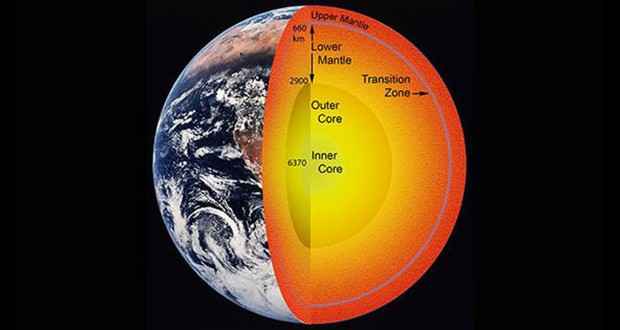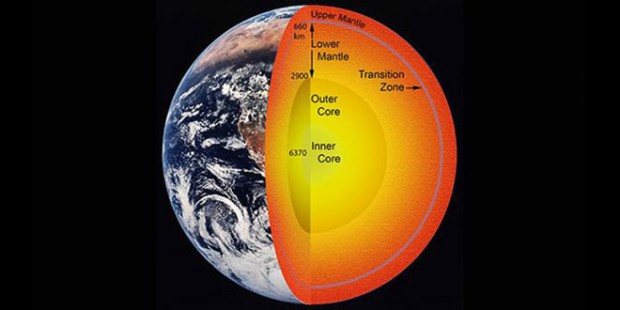گروهی از محققان دانشگاه ایلینویز و دانشگاه نانیانگ چین با استفاده از فناوری خوانش زلزله دریافتهاند هسته درونی کره زمین خود دارای یک هسته درونی است.بررسیهای دانشمندان نشان میدهد این هسته درونی دارای ویژگیهای شگفتانگیزی است که اطلاعات مهمی درباره کره خاکی در اختیار زمینشناسان قرار خواهند داد.
گرچه هسته درونی زمین کوچک است (کوچکتر از ماه)، این مولفه میتواند اطلاعاتی درباره چگونگی شکلگیری زمین، تاریخ و فرآیندهای دینامیک موجود در پس آن ارائه دهد. این موضوع درک جامعه علمی از آنچه در اعماق کره خاکی میگذرد را افزایش میدهد.
محققان از امواج لرزهیی زمینلرزهها برای اسکنکردن زیر سطح زمین استفاده میکنند و تیم علمی حاضر در این مطالعه، از فناوری استفاده کرد که دادهها را نه از شوک اصلی زلزله بلکه از امواجی جمعآوری میکند که پس از زمینلرزه مرتعش میشوند.
دانشمندان حاضر دریافتند هسته درونی زمین که زمانی تصور میشد از یک گلوله منجمد آهنین تشکیل شده، دارای ویژگیهای ساختاری پیچیدهای است. تیم علمی، هسته درونی – درونی مجزایی را یافت که قطر آن نصف قطر هسته درونی کلی است. بلورهای آهن در لایه خارجی هسته درونی از سمت شمال به جنوب آرایش شدهاند، با این حال، هسته درونی-درونی زمین از بلورهای آهنی تشکیل شده که تقریبا از جهت شرق به غرب آرایش شدهاند.
نه تنها بلورهای آهنی در هسته درونی-درونی به طور متفاوتی آرایش شدهاند، بلکه این مولفهها رفتار متفاوتی از اجزای موجود در هسته درونی دارند. این بدین معناست که هسته درونی-درونی میتواند از نوع متفاوتی از بلور تشکیل شده باشد.
یافتههای جدید نکتههای جالبی درباره چگونگی تکامل هسته درونی زمین و همچنین خود کره خاکی ارائه میدهند.
منبع : discovery
Earth's Inner Core Has Its Own Inner Core
Earth's Inner Core Has Its Own Inner Core
Scientists once thought that the Earth’s core was composed of an outer core of liquid iron and a solid inner core of iron crystals that are aligned in a North-South direction. But, as it turns out, there’s also an inner-inner core, whose crystals point East-West. The inner-inner crystals behave differently also.
NEWS: Earth’s Core 1,000 Degrees Hotter Than Expected
“Even though the inner core is small – smaller than the moon – it has some really interesting features,” said University of Illinois geology professor Xiaodong Song, co-author of a study just published in the journal Nature Geoscience. “It may tell us about how our planet formed, its history, and other dynamic processes of the Earth. It shapes our understanding of what’s going on deep inside the Earth.”
“The fact that we have two regions that are distinctly different may tell us something about how the inner core has been evolving,” Song said in a press release. “For example, over the history of the earth, the inner core might have had a very dramatic change in its deformation regime. It might hold the key to how the planet has evolved. We are right in the center – literally, the center of the Earth.”
[WATCH: Water, Water Everywhere … 400 Miles Inside EarthCambridge University professor Simon Redfern told BBC News that the new study is significant, because it means that “something very substantial happened to flip the orientation” of the inner-inner core. He said other studies suggest that the Earth’s magnetic field underwent a major change in the distant past, switching alignment between the equator and the polar axis.
“It could be that the strange alignment Prof. Song sees in the innermost core explains the strange palaeomagnetic signatures from ancient rocks that may have been present near the equator half a billion years ago,” Redfern told BBC.
The Earth’s inner core has its own inner-inner core. Credit: Lachina Publishing Services, via University of Illinois
 گجت نیوز آخرین اخبار تکنولوژی، علم و خودرو
گجت نیوز آخرین اخبار تکنولوژی، علم و خودرو 







